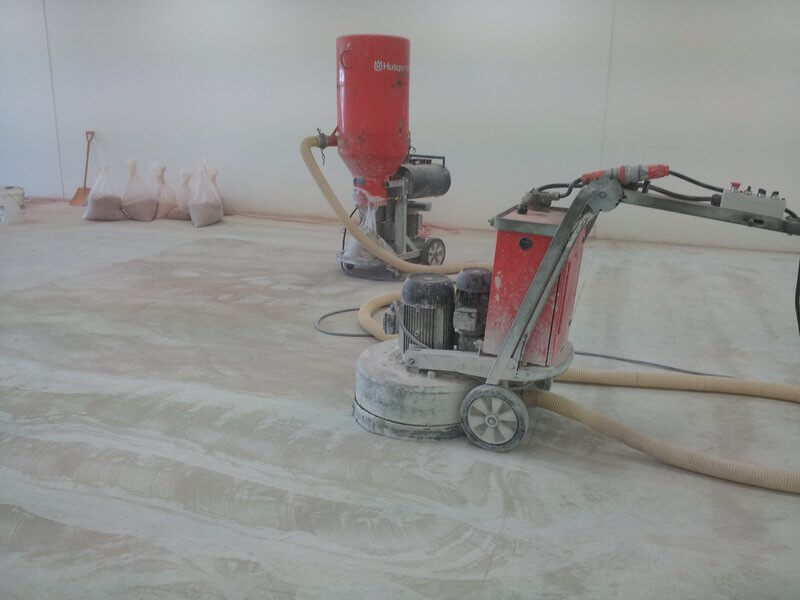Preparatory work for grinding
- Always keep in mind that “safety is the priority”. Do remember to wear the PPE (Personal protective equipment), including the dust mask, ear protection, goggle, foot and hand protection devices.
- Measure the size of the floor and choose the right equipment to do the job, is the satellite grinder, cub floor grinder or hand grinder is needed? Anyway, choose the right tool will yield twice the result with half the effort.
- Check the floor condition, to check if the floor is damaged too much or wear out too much. If so, patching or crack chasing will be needed before grinding.
- Measure the hardness of the floor to decide which type of metal bond diamonds should be used. The hardness of the concrete floor is normally classified by Mohs’ hardness, generally, the hardness of concrete floor ranges from 3 to 5. On the site, we can find some substitution to the durometer, the keys or iron nail for instance. If we can make scratches on concrete floor by keys or iron nails, then the hardness is below 5, otherwise it is higher than. Make sure to check several areas on the floor, because the hardness is different from slab to slab.
- If the walk behind floor grinder is needed to do the job, then take care to keep the grinder flat. Because the gouges will be generated if you hold the floor grinder on an edge. It is difficult to remove the gouges.
- Prepare the diamond grinding tools to be used in the whole grinding process. Generally below are the frequently used diamond tools: Diamond grinding cup wheels, grinding diamonds, polishing pads, grinding plates, PCD diamond tools
Equipment and tools to be used
Steps of Grinding
Step 1.
Connect the handheld grinder or walk behind grinder with the dust extraction system. Start the grinder machine and carefully grind around the perimeter of the working area. This is the testing process, on one hand, to check if the grinder machine is running well, on the other hand, we can check if the concrete is too soft causing excessive wear or the concrete is too hard and it is not grinding much at all.
Step 2.
Fix medium bond 30/40# metal bond tool to handheld grinder or walk behind grinder, Start at one side and grind from“west to east” across the entire concrete floor. Make sure to overlap the grinding pass as close as possible to the previous grinding pass.
Clean up the floor with vacuum or scrubber, this cleaning step is to clear up all the dust and residual diamond grit come off the tools, if the cleaning job is not done, the residual diamond grit will leave scratches on the floor.
Tips #1: 30/40# tool is for standard concrete grinding, usually the concrete is medium hard and there isn’t heavy sealer on the floor. However, if the concrete is extremely hard and there is sealer on it, pls choose the 14/16# to start this step
Tips #2: Running the grinder at a lower RPM, almost half the speed of the grinder. Because the main object is to expose the aggregate, lower the grinder speed can allow the diamonds to penetrate the floor without overheating too early. The sign of the optimum RPM is that there is a lot dust generated during grinding process.
Step 3
Change the direction and go “north to south” pass, still take care of the overlapping, make sure the grinding passes overlap one another as close as possible.
Do the same cleaning job as you did in step 2 after the “north to south” pass completed.
It is better to use grind the floor in swing style, in this way, the grinding passes can be blended. Also, take care of your pace during grinding, it is great if the grinder leaves solid grinding pass. However, if there is swirl grinding passes on the floor that means you push the grinder too fast, you need to slow down. Also, there may be the occasion that the grinding speed becomes slow suddenly, it is possible that the soft top layer has been remove off, the harder concrete comes out, so you need to replace the medium hard tooling with a more softer bond.
The Step 2 and Step 3 determine if the concrete floor has a good finished “looking”. So, after the “north to south” pass completed, have a short break, check the entire floor carefully. If the exposed aggregate doesn’t meet your expectation, then go back and repeat step 2 and step 3 until get the exposed aggregate as you want.
Step 4 (optional)
Patch or repair work can be done in this step. Also, if the floor needs crack chasing or filling, then arrange it in this step.
Step 5
Replace the medium hard 30/40# tool with Medium hard 60/70#, grind the perimeter of the floor as you did in step 1.
Step 6
Still use the 60/70# tooling, repeat step 2 and step 3, grind “east to west” first, and then go for “north to south”
The initial scratches left by the 30/40# should be removed in this step, if you still can see the significant scratches, then pls repeat step 5 until all the big scratches are gone.
Remember to vacuum the entire floor area before moving to next step.
Step 7
Change to the 120/140# diamond tooling, and then repeat step 2 and step 3. Vacuum the entire floor area carefully and check your grinding job so far. Do extra grinding job if needed.



